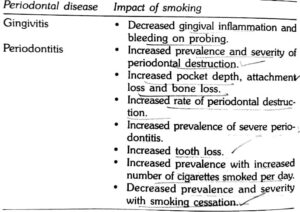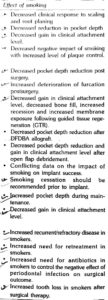EFFECT OF SMOKING ON THE ETIOLOGY AND PATHOGENESIS VOF PERIODONTAL DISEASE
Microbiology
Smokers had higher level of Bacteroides forsythus. Smokers do not respond to mechanical therapy and this is associated with increased level of B.forsythus,

A. actinomycetemcomitans and P. gingivalis remaining in the pocket after therapy when compared to nonsmokers.
Eikenella nodatum, Fusobacterium nucleatum, S. vincentii, P. gingivalis, P. intermedia, Peptostrepto- coccus micros, Prevotella nigrescens, B. forsythus were significantly more prevalent in current smokers than in nonsmokers and former smokers.
Immunology
Altered neutrophil chemotaxis, phagocytosis and oxidative burst.
• Increased TNF-α, and PGE2 in GCF.
Increased production of PGE, by monocyte in response to lipopolysaccharides (LPS).
IgG, level is reduced suggesting reduced protection against periodontal infection.
Nicotine, a major component of tobacco adversely affect fibroblast function.
Nicotine suppresses osteoblast proliferation while
stimulating alkaline phosphatase activity.
Tobacco products alters normal reparative and regeneration potential of periodontium.
Physiology
Clinical signs of inflammation are less pronounced, due to alteration in the inflammatory response in smokers or due to alteration in vascular response of gingival tissues.
Increased gingival blood vessels with increased inflammation.
Decreased GCF flow and bleeding on probing with
increased inflammation.
• Decreased subgingival temperature. • Increased time needed to recover from local anes- thesia.
EFFECT OF SMOKING ON THE
RESPONSE TO PERIODONTAL THERAPY

EFFECT OF SMOKING CESSATION
Gingiva of treated current smokers exhibit minimal redness and bleeding while brushing presumably because of immunosupression or vascular effect of smoking.
Several weeks following smoking cessation, gingival inflammation and bleeding on brushing occurs because of smoking cessation, gingiva loses its thick fibrotic appearance and assumes normal anatomy. Therefore smoking status should be considered in diagnosis, prognosis and treatment planning of periodontitis patients.